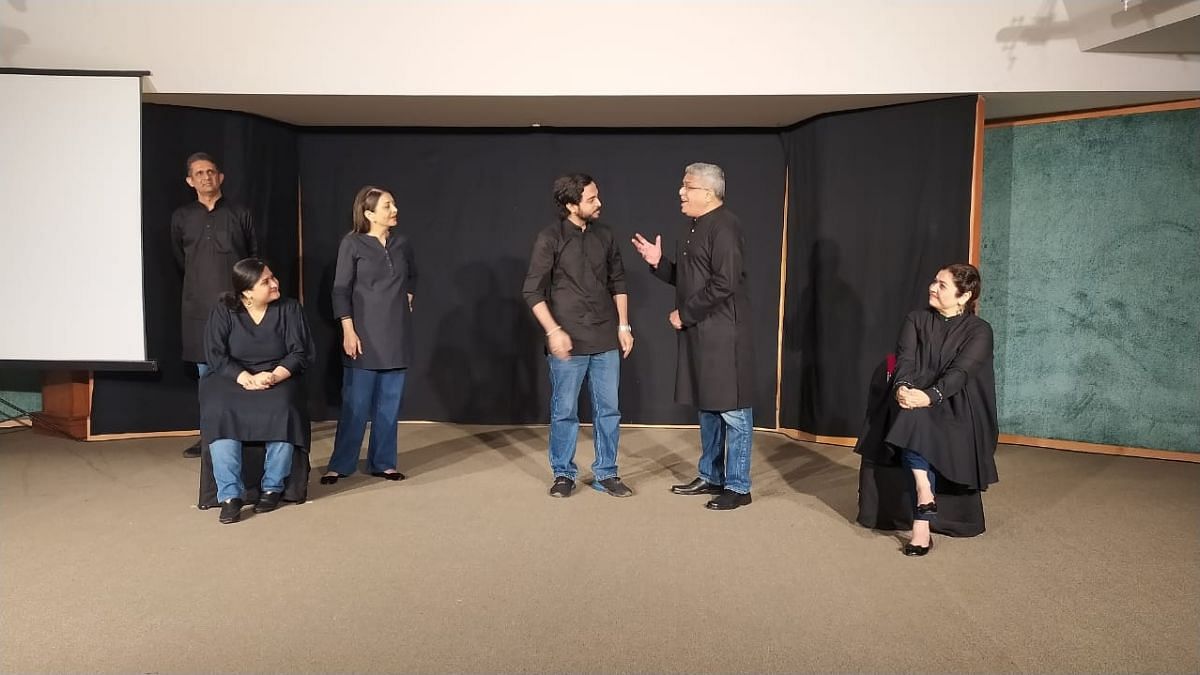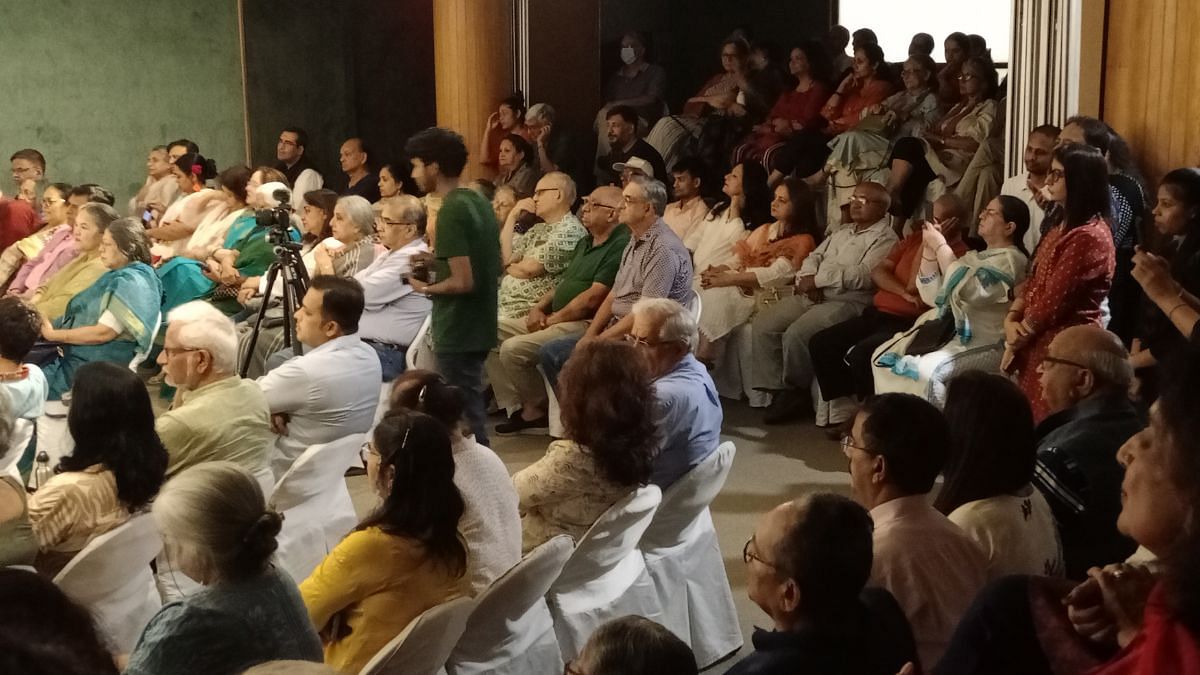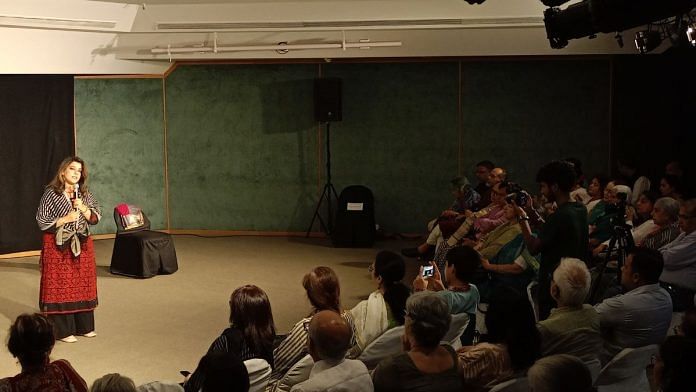The way the theatre of India Habitat Centre in Delhi was jam-packed recently — with many senior audience members standing up — it’s not hard to guess how yesteryear legend Talat Mahmood’s live performances would have looked like. This one was a multimedia reading of Talat Mahmood: The Definitive Biography, written by the ghazal king’s grandniece Sahar Zaman to commemorate his centenary year on 21 June.
The show titled Talat Mahmood – Reluctant Hero, Superstar Singer saw a seven-member troupe dressed in black kurtas take up different roles — from Dilip Kumar, Suraiya, Mehdi Hassan to Mukesh. Nidhikant Pandey played the character of Mahmood.
Songs such as Jalte Hain Jiske Liye from Sujata (1959) and Phir Wahi Sham from Jahan Ara (1964) were played on a screen placed behind the stage as artists performed. For an hour, the performance put the people in a time capsule, leaving them lost in Mahmood’s songs of heartbreak, love and loss.
Some in the audience were also left teary-eyed. Sumit Jain, an engineering student, had accompanied his grandfather for the performance. “I think today is a bonding moment, like the way it used to be when he (the grandfather) would play these songs while I spent summer vacations at his house,” he said.

Rebel for a cause–the many sides
Part history lesson, part fascinating story, the show delved into the fight for royalty rights spearheaded by the singer when he led the Playback Singers’ Association in the 1960s. When the actors started narrating how Mahmood was leading from the front, the audience was surprised. For those who have known the singer only through his songs, the play was a perfect way to get an insight into the politics of the Hindi film and music industry of his era.
“The studios were shut for almost three months during this time. It was a pretty serious movement, even though it failed then,” said Zaman.
The theatrical show had choreography, projection, performance-enacting characters, and narration. Even Mahmood’s love story with his wife Nasreen was shown as one actor offered a red flower to another. She gently tucked it behind her ear, and the audience clapped and cheered. It was as if they could see Mahmood’s life playing out in real life.

The show also gave interesting trivia about the singer’s charm. The performance mentioned what actor Shyama thought of her co-star Dil-E-Nadaan (1953). In a conspiratorial manner, the actor playing Shyama in the multi-media show revealed how her crush on Mahmood knew no bounds and she had hoped to marry him.
The 81-year-old Three Arts Club performing at the event has a special connection with the singer. In 1957, Mahmood was invited by the theatre club to perform at Sapru House.
“I have been a Talat fan since my teenage years when I used to listen to the radio in our house. In fact, both my first romance and heartbreak were spent listening to many of his songs,” said Suraj Munshi, a retired government employee, whose friend had told him about the event. Munshi arrived 15 minutes after the show started, and watched it standing and recording it on his phone, despite struggling with knee pain.
Through monologues, the thoughts of various peers of Mahmood were also shared in the hour-long performance. Actors portrayed his contemporaries and shared their memories of the singer, whose Urdu diction even Kishore Kumar admired and acknowledged.
Also read: Babur’s barbarism to bisexuality, new book leaves nothing out
Peers, fans and legacy
Zaman recalled one incident that shows the professional rivalry between Mohammad Rafi and Mahmood was devoid of any ill-will.
“There is an image of him kissing Rafi’s forehead after the latter had passed away, and the body was laid out for people to offer their last respects before cremation. That really shows the kind of respect he had for his peers,” said Zaman.
The show also highlighted the extent of Mahmood’s influence, which extended beyond borders. People almost broke through barricades in Karachi when the singer visited the city to visit family. He also performed there. Zaman’s book claims that Pakistani legend Nur Jahan even offered the singer a blank cheque to make his career in Pakistan.
A character delivered a testimonial of Pakistan’s musical icon Mehdi Hassan, who was inspired by Mahmood not only to sing but also learn from his radio performances, forging an illustrious career despite many rejections, including being called a ‘feminine’ voice. At a public performance in Karachi in 1957, he sang Husnwalon Ko Na Dil Do from Babul (1950) and Ek Main Hoon Ek Meri Bekasi Ki Shaam Hai from Tarana (1951).
The performance ended with one of Mahmood’s ghazals, ‘Meri yaad me tum na aansoo bahana’ from Madhosh (1951), which translates to ‘Do not shed tears thinking of me’.
“I think it is an apt ending to the piece, and for the artist who also liked his retirement. He gave his all to his art, but was also happy to live his life once it was over,” said Kapoor.
(Edited by Ratan Priya)






